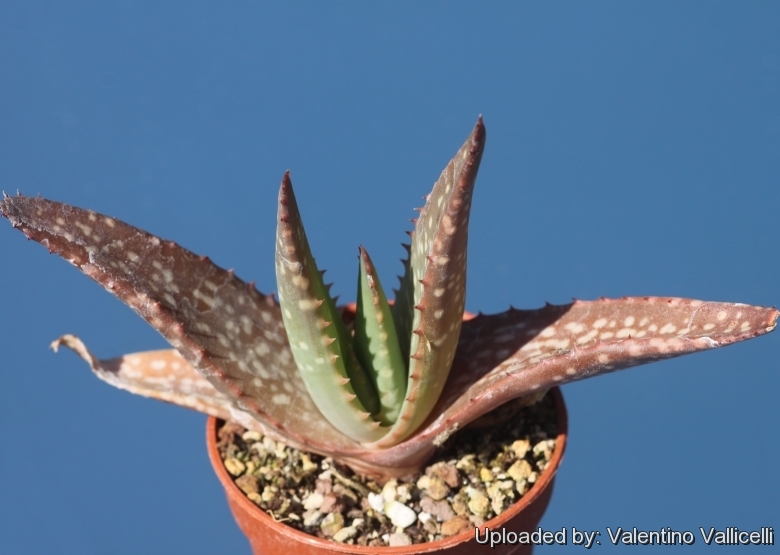
Aloe tomentosa Photo by: Valentino Vallicelli
Typically has leaves that are very smooth, and uniformly grey-green, with toothed edges, but seedlings have some nice mottling.
Origin and Habitat: Saudi Arabia, Yemen.
Altitude range: 1430 - 3050 metres above sea level.
Habitat and ecology: This species is found on high-altitude rocky slopes together with Aeonium leucoblepharumSN|31649]]SN|31649]], Euphorbia balsamifcra ssp. adenensis and Kniphofia sumarae. Aloe tomentosa sometimes grows together with Aloe vacillansSN|31643]]SN|31643]] and when crossed creates the hybrid Aloe x menachensis.
Synonyms:
See all synonyms of Aloe tomentosa
back
Accepted name in llifle Database:Aloe tomentosa DeflersVoyage Yemen 211 (1889)Synonymy: 2
back
Common Names include:
ENGLISH: Hairy Green Aloe
Description: One of the many aloes from the Arabian peninsula, Aloe tomentosaSN|31656]]SN|31641]] is characterized by yellow to pinkish flowers, which are distinctly covered with dense white hairs or wool. The inflorescence is well branched and grows to over l metre in height. It is easy to cultivate and makes a good landscape plant in warm climates.
Habit: Shrubby, caulescent, rarely suckering. Multiple plants are more likely divided heads.
Stem: Decumbent, short, thick.
Leaves: 16 - 20, densely rosulate, sword- shaped, thick, narrowed towards base, about 35 long and 9 cm wide, smooth, uniformly grey-green, glaucous, and in some cases, near transluscent, often tinged reddish – though some plants may have stripes or a slight mottling. Margins narrow pinkish-brown cartilaginous. Marginal teeth 0.5 - 1 mm long, blunt, 20 - 40 mm apart, sometimes absent; exudate drying pale yellow. Juvenile specimens have pale green leaves with many white dots and dashes.
Inflorescence: 60 - 80 cm high, elongated, with 3 - 4 branches; racemes cylindrical-conical, to 15-17 cm long, 5 - 6 cm in diameter, subdense. Bracts ovate-deltoid, 7 x 4 mm. Pedicels 6 - 9 mm.
Flowers: Rose-pink ( also encountered in orange and yellow), with minute hairs, 24 - 28 mm long, base rounded, 7 - 8 mm across. Ovary slightly narrowed above. Tepals free for 9 mm.
Blooming season: Late summer.
Notes: Unusual woolly flowers are also shared in Africa by Aloe molederanaSN|31655]]SN|31654]] and in Saudi Arabia by either Aloe parvicapsulaSN|31654]]SN|31655]] or Aloe woodiiSN|31641]]SN|31656]].
Bibliography: Major references and further lectutres
1) Graham Charles “Cacti and Succulents: An illustrated guide to the plants and their cultivation” Crowood, 30 April 2014
2) Urs Eggli “Illustrated Handbook of Succulent Plants: Monocotyledons: Monocotyledons” Springer Science & Business Media, 17 July 7 2001
3) Wahbi Hariri-Rifai, Mokhless Hariri-Rifai “The Heritage of the Kingdom of Saudi Arabia” GDG Exhibits Trust, 1990
4) S.A. Ghazanfar, M. Fisher “Vegetation of the Arabian Peninsula” Springer Science & Business Media, 17 April 2013
5) Gilbert Westacott Reynolds “The Aloes of Tropical Africa and Madagascar” Aloes Book Fund, 1966
6) Hermann Jacobsen “Abromeitiella to Euphorbia” Blandford Press, 1960
7) Hermann Jacobsen “A Handbook of Succulent Plants: Descriptions, Synonyms, and Cultural Details for Succulents Other Than Cactaceae” Volume 1 Blandford Press, 1960
8) Betty A. Lipscombe Vincett “Golden days in the desert: wild flowers of Saudi Arabia” Immel, 01 December 1984
 Aloe tomentosa Photo by: Valentino Vallicelli
Aloe tomentosa Photo by: Valentino VallicelliSend a photo of this plant.The gallery now contains thousands of pictures, however it is possible to do even more. We are, of course, seeking photos of species not yet shown in the gallery but not only that, we are also looking for better pictures than those already present.
Read More... Cultivation and Propagation: Aloe tomentosaSN|31641]]SN|31641]] is one of the most ornamental aloes that is a fast-growing species that can reach full size in 5 or 6 years (if given proper growing conditions) and is probably hardier than most would assume since it grows above 2500 metres. Like most Aloe species, this plant is a water-wise plant that may be used in xeriscaping and can grow outdoors in those areas where there is light frost in winter and the rainfall is not too high.
Soil: It should be given a well-drained soil with a high lime content. The plant grows well in a pot too, and can be moved indoors for the winter
Exposure: Outside, if the climate is cool it enjoys full sun. In warmer country, keep it cool by filtering the afternoon sun, and also avoid using a dark-coloured container.
Water: Aloe tomentosaSN|31641]]SN|31641]] is an ideal water-wise plant, especially in arid and semi-arid regions, but it comes from summer-rainfall areas, and appreciates consistent moisture during the summer months. As the plant gets established, reduce the amount of water and don't water at all during the rainy season. Established plants can take care of themselves as they store water in their leaves and are well adapted to an arid environment.
Hardiness: This is a winter dormant aloe. Although from the warmer and more tropical Arabian Peninsula, this plant has proven hardy in unprotected gardens to temperatures down to -7° C.
Pests and diseases: It is susceptible to snout weevil and scale infestation, and to fungal infections. If in a pot try not to over water plants, tilt the pot so water never sits in the rosette. Water sitting in the rosette is the greatest cause of rotting these plants.
Uses: The plant's succulent leaves contain natural antibiotics and are said to have healing properties.
Propagation: This plant is propagated from seed. To grow the seeds keep them wet at all times do not let them dry out, 10-18 days and you will have success. Keep the soil wet for young ones until they are able to transplant into a larger container. When growing this aloes from seed there is one important consideration to bear in mind, the young plants are fairly slow growing and a systemic fungicide should be added to the watering as the they are very vulnerable.Take care not to over-water the seedlings, too much water may cause them to rot.











